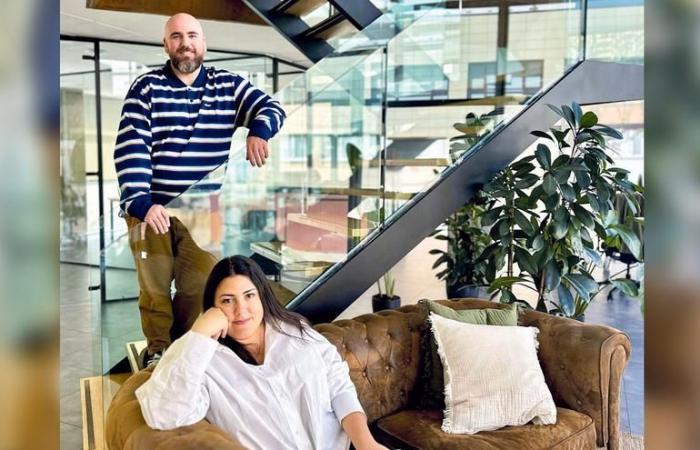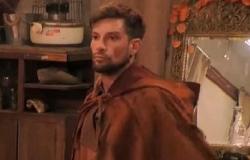Narrative spaces have become a key piece to connect with people, establishing themselves as a new way to convey brand values and identity. Transforming a physical environment such as a museum, a store, a restaurant, an office or an exhibition venue into an immersive experience where the visitor is immersed in an experience full of sensations and emotions is the objective of the team led by the architects Laura Pérez, from Lugo, and Carlos Rubio, from La Mancha living in A Coruña since he was 14, leaders of Spaces, a new division of the Experientia business group, based in Madrid. They have led the team in charge of designing the Legends museum. The Home of the Football in the heart of Madrid’s Puerta del Sol, the first foray into museography of the company, which thus begins its journey in the creating spaces that tell stories.
The path of these two young people has been parallel. Both are 35 years old and have followed a similar educational and professional path. Graduates in Architecture from the private Cesuga University of A Coruña, where the degree awarded by the University College of Dublin was taught, upon finishing their degree they carried out internships at the Kossmanndenjong museography studio in Amsterdamwhere they coincided with a multidisciplinary team like the one they lead now, made up of architects, graphic designers, illuminators, content creators, experience generators and specialists in other technical disciplines. “That opened our minds to do our work in something more focused on the most artistic and creative architecturebecause when you leave your degree it seems that you are only going to dedicate yourself to building houses,” they explain.
Facade of the Legends museum, in a 19th century building in Madrid’s Puerta del Sol.
After their stay in the Netherlands, they returned to Spain and continued specializing in the architectural design at the service of marketing and museography, she in a master’s degree in Retail Design focused on businesses and stores, and he in ephemeral architecture, public space and art and design. Their first professional experience together in Spain was making film sets for the Galician film Dhogs, for which they designed a couple of storyboards before an events company in the field of experiential marketing called them to work at their headquarters in Barcelona.
“All this background allowed us to develop a perspective in which we realize that the market has changed and brands now want to connect with their consumers/viewers without directly selling them the message of ‘buy my product’, but also offering them something that adds cultural value, through museography, and transmit stories that excite the user,” they say. In this way, from the company where they now work, Spaces, they address different agents, not only companies but also institutions, interested in exploring this new cultural vertex that makes up the triangle of your communication with the public. Sportswear, food, beverage and automotive brands are already putting their eggs in that basket, as fashion brands have done previously. Some examples are Inditex through the Marta Ortega Foundation or Loewe with its pop-ups.
Narrative space of the Madrid football museum.
The project that supports them and serves as their business card is the Legends: The Home of the Football museum, a space of 4,200 square meters and seven floors in a building in the heart of Puerta del Sol in Madrid that brings together all the history and passion for the beautiful game with immersive experiences in which visitors can contemplate more than 600 historical objects from the world of football.
Behind this initiative is Marcelo Ordás, president of Legends, and owner of the largest private collection of historical football shirts and pieces, with whom Laura Pérez and Carlos Rubio were working side by side for two years. “Upon meeting him and working with him, we quickly realized that behind each shirt there was an exciting story of what it represented and how Marcelo got it; and that story had to be told,” say the architects. “I, who am not a soccer fan, was moved by what he told us; To give an example, there is a t-shirt of the argentine national team that has a large hole in the middle of his torso and he tells me that it belongs to Tata Brown, a player from a humble family who had played with a dislocated shoulder in the 1986 World Cup despite the fact that the referee had recommended that he go to the bench; “He wanted to continue in the game and tore his shirt to make a kind of sling,” says Laura Pérez. “I, who am a soccer fan, immediately realized the incalculable value of that collection of used shirts and incredible pieces of soccer history from the beginning of the 20th century,” supports Carlos Rubio.
Between museum and show
This tandem of Galician architects They led the team of more than two hundred professionals who intervened between the civil works, the design, the production of audiovisual content and the conservation of the pieces. “We are looking for the middle ground between the concept of a classic museum that exhibits pieces explained with texts on the wall and experiences that only serve to take Instagram photos because they do not explain anything to you and are only based on a beautiful show with lights and pieces floating around. the middle”.
Narrative space of the Madrid football museum.
To find that balance, they used various channels that team up to tell the story in a very immersive way for the viewer, as well as fun, spectacular and educational. A tour of the museum reveals to the visitor the history of football and infects them with the passion of its promoter, who has partnered with the League to own this space. On the first floor there is national team football, a space dedicated to the World Cup held in Spain in 1982, the moment in which the red team was world champion in South Africa in 2010, a review of the League champions and a space reserved for the derbies, including Deportivo-Celta. The second floor is dedicated to the Euro Cup and the Copa Libertadores, the grand finals are present while the anthems play and a 4D cinema (the fourth dimension is the sensory one) immerses the visitor in a journey through history and geography. The most epic moments of all the world football championships take up the content of the third floor, where, sitting in an armchair, the visitor travels on a kind of sensory roller coaster through different stadiums, cities and historical football episodes, such as the legendary macaranazo in which Brazil lost against Uruguay. The museum experience closes on the fourth floor with the crown jewels, the great pieces of the collection worn in their day by immense players, among them the shirt that Maradona wore in the 1986 World Cup in Mexico, rescued by Marcelo in a church from Brazil to which he had to fix the roof to get the garment.
A restaurant with a terrace overlooking Puerta del Sol, on the top floor, a video game area for the youngest, in the basement, and the store on the ground floor complete the immersive museum experience.
A 19th century palace
The building that houses the Legends museum, listed as Asset of Cultural Interest, It is a palace built in 1880, which was later converted into a convent and later fragmented into partitions for use as commercial premises, offices, a hostel, warehouses and a teaching centre. “As architects, in the rehabilitation phase we had to apply what we learned in college, there were many elements that we had to protect and leave them as they were in the 19th century, so we had to restore some and replicate others, without creating false historical records” , that is, avoiding imitating styles that can be misleading. In this way, the central staircase of the museum is the original, while the one that connects the ground floor with the basement is completely modern, since it did not exist. In fact, when they were preparing to renovate the abandoned basement, they found remains that had to be classified by archaeologists.
Another example of conservation can be seen in the museum store, in which two parts can be distinguished: the oldest, occupied by the most vintage objects for sale, is located in what was an old shawl shop, which was They found it in a state of abandonment and completely blackened, from which as soon as they brushed the black lacquered furniture a precious wood with wooden inlays emerged. The most modern part is newly built, where the newest pieces are for sale.
‘Sin Límites’ project, designed in a replica of the boat in which Magellan and Elcano made the first circumnavigation of the world more than 500 years ago.
A Legend in Riyadh
A few weeks after finishing the project in Madrid, the architects were commissioned to design a new Legend museum for Saudi Arabia in record time, as it had to be ready for the start of the fall season at Boulevard City, the largest leisure center. from Riyadh. It was June and the scheduled opening date was in October, so they had four months to transform an open-plan warehouse of 2,500 square meters into a museum space that displays 220 pieces from the largest collection in the history of world football, through immersive experiences and interactive technology.
An experience with Elcano
Prior to these two museum spaces, this tandem of architects carried out another project of disruptive storytelling (narrate content using different channels other than those traditionally used in museums and exhibitions) with the replica of the boat in which Elcano and Magellan made the first trip around the world more than 500 years ago. Coinciding with the fifth centenary of the event and taking advantage of the ship used for the series of Amazon Prime Without limits, They were commissioned to recreate part of the historical context for a temporary experience in Madrid aimed at disseminating this historical milestone among children in an entertaining way.
“It was necessary to explain the historic context, the role of the king in financing the expedition, who Magellan and Elcano were and where they came from, and we had to recreate Seville,” they explain. Using giant fabrics six meters high, they replicated historic buildings in the Andalusian city, including the Archivo de Indias, and using props they created different areas of the town, the one closest to the port with aromas of wood and the most urban one with the smell of bonfire. “As you walked, you met actors who played inhabitants of Seville from different social classes and, through the conversations they had, you learned that there was going to be an expedition to go around the world, how the rich lived and how the poor lived and other historical details,” they say.
Among the upcoming projects they are considering is one for the city of Vigo about which they cannot yet announce anything. “It is something of cultural character and of our own initiative that could fit very well and that we would be very excited to carry out,” they advance.






